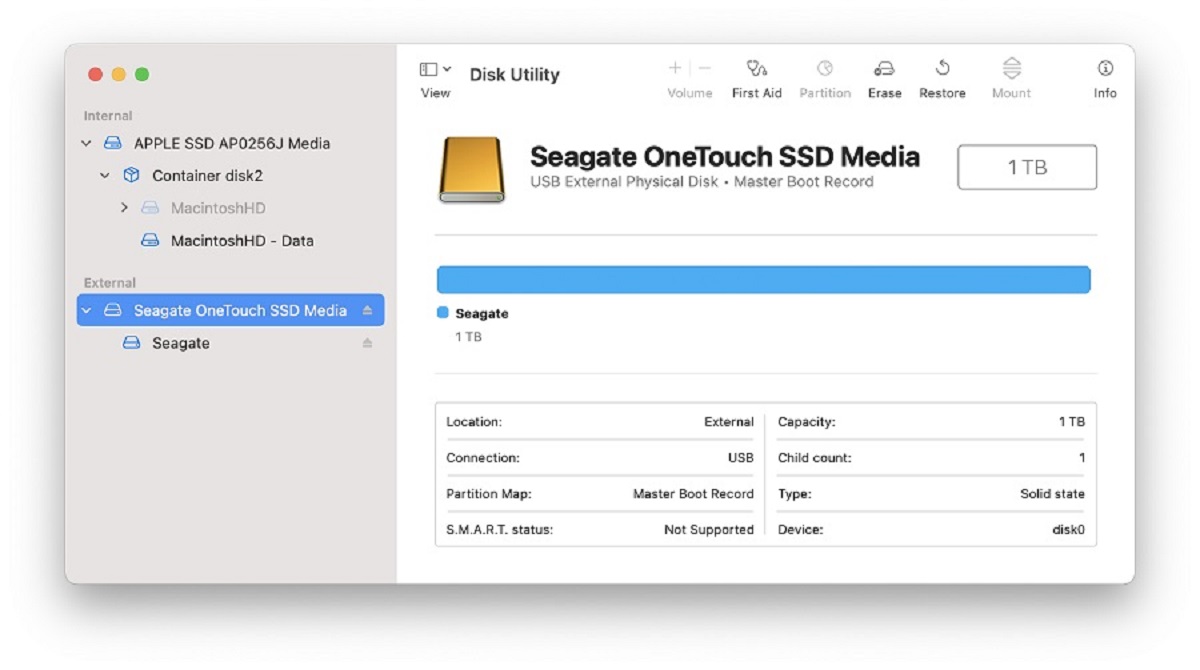Introduction
Are you looking to reformat your solid-state drive (SSD) on a Mac? Whether you’re planning to sell your computer, troubleshoot performance issues, or simply start fresh, reformatting your SSD can be a beneficial step. Reformatting erases all the data on your SSD and prepares it for a fresh installation of the operating system or for transferring your data back onto it.
In this article, we will guide you through the step-by-step process of reformatting a solid-state drive on a Mac. It’s important to note that reformatting will permanently delete all the data on your SSD, so make sure you have backed up any important files before proceeding.
Before we dive into the steps, let’s quickly go over what a solid-state drive is. An SSD is a type of storage device that uses flash memory to store data and offers significantly faster read and write speeds compared to traditional hard drives. It’s become the preferred choice for many Mac users due to its speed and reliability.
Reformatting your SSD can help resolve performance issues, eliminate viruses or malware, and ensure a clean slate for your Mac. It’s a fairly straightforward process, but it’s important to follow the steps carefully to avoid any potential data loss or errors.
Now that you understand the importance and benefits of reformatting your SSD, let’s jump into the step-by-step guide on how to successfully reformat your solid-state drive on a Mac.
Step 1: Backup your data
Before you begin the reformatting process, it’s essential to backup all your important data. Reformatting will erase everything on your solid-state drive, so it’s crucial to have a copy of your files to avoid permanent data loss.
There are several methods you can use to back up your data on a Mac. One of the most convenient ways is to use Time Machine, a built-in backup feature in macOS. With Time Machine, you can automatically back up your entire Mac, including files, applications, and operating system settings, to an external hard drive or network storage device.
To backup your data using Time Machine, follow these steps:
- Connect an external hard drive or network storage device to your Mac.
- Go to “System Preferences” on your Mac.
- Select “Time Machine.”
- Click on “Select Backup Disk” and choose the external hard drive or network storage device you connected.
- Turn on Time Machine by ticking the “On” slider.
Once you’ve set up Time Machine, it will automatically back up your files in the background. It’s recommended to let the backup process complete before proceeding with the reformatting to ensure all your files are safely stored.
Alternatively, you can also manually backup your data by copying your important files to an external hard drive or using cloud storage services such as iCloud, Dropbox, or Google Drive. Simply select the files you want to back up and drag them to the external storage device or the cloud storage folder.
Remember to double-check that you have successfully backed up all your important files and verify their integrity before proceeding to the next step. This ensures that you can easily restore your files to your Mac after the reformatting process is complete.
With your data safely backed up, you can now move on to the next step to prepare the necessary tools for reformatting your solid-state drive on a Mac.
Step 2: Prepare the necessary tools
Once you have backed up your data, it’s time to gather the necessary tools to reformat your solid-state drive (SSD) on a Mac. Here’s what you’ll need:
- External Bootable Drive: You will need an external bootable drive that contains the macOS installation files. This can be a USB flash drive or an external hard drive. Make sure it has enough storage space to accommodate the macOS installer.
- macOS Installer: You will need to download the macOS installer from the App Store. The installer is available for free and can be downloaded on any Mac running macOS High Sierra or later. The macOS installer will be used to reinstall the operating system on your SSD after reformatting.
- Internet Connection: Make sure you have a stable internet connection to download the macOS installer and any necessary updates during the reinstallation process.
- Mac Recovery Partition: The Mac recovery partition is a built-in feature that allows you to troubleshoot and perform maintenance tasks on your Mac. It’s essential to ensure that your Mac has a recovery partition before proceeding. You can access the recovery partition by restarting your Mac and holding down the Command (⌘) and R keys simultaneously.
Before moving on to the next step, ensure that you have all the required tools in place. If you don’t have an external bootable drive or the macOS installer, you can create them by following the guides provided by Apple on their official support website.
Having the necessary tools ready ensures a smooth and hassle-free reformatting process for your solid-state drive. With everything prepared, you can move on to the next step and erase your SSD using Disk Utility.
Step 3: Erase the SSD using Disk Utility
Now that you have your external bootable drive and macOS installer ready, it’s time to erase your solid-state drive (SSD) using Disk Utility. Disk Utility is a built-in utility in macOS that allows you to manage and format storage devices.
Follow these steps to erase your SSD using Disk Utility:
- Connect the external bootable drive to your Mac.
- Restart your Mac and hold down the Option (⌥) key.
- Select the external bootable drive as the startup disk and press Enter.
- Once your Mac boots from the external drive, select “Disk Utility” from the macOS Utilities menu.
- In Disk Utility, locate your SSD in the sidebar and select it.
- Click on the “Erase” button at the top of the Disk Utility window.
- Give your SSD a new name, choose the desired format (APFS or Mac OS Extended), and select a scheme (GUID Partition Map for Intel Macs or Apple Partition Map for PowerPC Macs).
- Double-check that you have selected the correct SSD, as erasing will permanently delete all data on the selected drive.
- Click on the “Erase” button to initiate the formatting process. This may take a few minutes to complete.
Once the formatting process is complete, your SSD will be wiped clean and ready to be formatted with the chosen format. Now that your SSD is formatted, you can move on to the next step and select the appropriate format (APFS or Mac OS Extended) for your SSD.
Please note that the steps provided may differ slightly depending on the version of macOS you are using. However, the basic principles of using Disk Utility to erase an SSD remain the same.
Step 4: Format the SSD with APFS or Mac OS Extended
Now that your solid-state drive (SSD) has been erased using Disk Utility, it’s time to format it with the appropriate file system. On a Mac, you have two options: APFS (Apple File System) or Mac OS Extended (also known as HFS+). The choice between the two depends on the version of macOS you are running and your specific needs.
Follow these steps to format your SSD with the desired file system:
- Open Disk Utility by selecting it from the macOS Utilities menu.
- Locate your SSD in the sidebar and select it.
- Click on the “Erase” button at the top of the Disk Utility window.
- Give your SSD a name and choose the desired format:
- If you are running macOS High Sierra or later, it is recommended to choose APFS. APFS offers improved performance, security, and compatibility with SSDs.
- If you are running an older version of macOS or have specific compatibility requirements, you can choose Mac OS Extended (Journaled).
- Choose the appropriate scheme for your SSD. For Intel-based Macs, select “GUID Partition Map.” For PowerPC Macs, select “Apple Partition Map.”
- Double-check that you have selected the correct SSD and formatting options.
- Click on the “Erase” button to begin the formatting process. This may take a few minutes to complete.
Once the formatting process is finished, your SSD will be formatted with the chosen file system and ready for use. If you plan to reinstall macOS on your newly formatted SSD, you can proceed to the next step. Otherwise, if you want to transfer your data back to the SSD, continue with the following steps.
Formatting your SSD with the appropriate file system is a critical step in preparing it for use. Make sure to select the file system that best suits your needs and ensures compatibility with your version of macOS. Now that your SSD is formatted, you can move on to the next step, where you will verify the formatting process and ensure the success of your reformatting efforts.
Step 5: Verify the formatting process
After formatting your solid-state drive (SSD) with the desired file system, it’s important to verify the formatting process to ensure that it was successful. This step will help confirm that your SSD is properly prepared for the next stage, whether it’s reinstalling macOS or transferring your data back onto the drive.
Follow these steps to verify the formatting process:
- Open Disk Utility by selecting it from the macOS Utilities menu.
- Locate your SSD in the sidebar and select it.
- Click on the “First Aid” button at the top of the Disk Utility window.
- Click on the “Run” button to initiate the First Aid process on your SSD.
- Allow Disk Utility to complete the verification process. This may take a few minutes.
Once the verification process is completed, Disk Utility will display a message confirming the status of your SSD. If the verification process is successful, it means that the formatting of your SSD was done correctly, and it is now ready for the next step in the reformatting process.
In the event that Disk Utility detects any errors during the verification process, it may attempt to repair them automatically. If the repairs are unsuccessful, you may need to consider reformatting your SSD again or seeking further assistance.
Verifying the formatting process ensures that your SSD is in a healthy state and ready for further usage. It provides peace of mind by confirming that everything is functioning as expected. Now that you have successfully verified the formatting of your SSD, you can proceed to the next step: reinstalling macOS or transferring your data back to the SSD.
Step 6: Reinstall macOS or transfer your data back to the SSD
Now that you have formatted and verified your solid-state drive (SSD), it’s time to decide whether you want to reinstall macOS or transfer your data back onto the drive. The choice will depend on your specific needs and requirements.
If you choose to reinstall macOS, follow these steps:
- Make sure you are connected to a stable internet connection.
- Restart your Mac.
- Hold down the Command (⌘) and R keys simultaneously.
- Release the keys when the Apple logo or a spinning globe appears.
- Select the option to “Reinstall macOS” from the macOS Utilities window.
- Follow the on-screen instructions to reinstall macOS on your SSD.
Reinstalling macOS will give you a fresh start with a clean operating system installation. Remember to follow the prompts and set up your Mac as desired.
If you choose to transfer your data back onto the SSD, follow these steps:
- Connect the external storage device that contains your backed-up data.
- Open the storage device and locate your backed-up data.
- Select the files and folders you want to transfer.
- Drag and drop your selected files and folders onto your SSD.
- Wait for the files to transfer to your SSD.
Transferring your data back onto the SSD allows you to retain your files, applications, and settings from your previous setup. It’s essential to double-check that all your important files and data have been successfully transferred before proceeding.
Once you have either reinstalled macOS or transferred your data back to the SSD, you can proceed with setting up your Mac according to your preferences and needs. Congratulations, you have successfully reformatted your solid-state drive on a Mac and are ready to utilize it to its full potential.
Conclusion
Reformatting a solid-state drive (SSD) on a Mac is a necessary process for various reasons, such as performance optimization, troubleshooting, or preparing for a fresh start. By following the step-by-step guide we have provided, you can successfully reformat your SSD and have it ready for the next chapter.
In this article, we covered the essential steps to reformatting an SSD on a Mac. It all starts with backing up your data to ensure you don’t lose any important files. Then, preparing the necessary tools, such as an external bootable drive and the macOS installer, is crucial. The third step involves using Disk Utility to erase the SSD, followed by formatting it with either APFS or Mac OS Extended in the fourth step.
Verifying the formatting process ensures that your SSD is healthy and ready for the next step. Finally, you have the choice to either reinstall macOS or transfer your data back onto the SSD. By following these steps, you can tailor your reformatting process to your specific needs and preferences.
Remember to exercise caution throughout the entire process and double-check each step to avoid any potential data loss or errors. If you encounter any difficulties or uncertainties, consider seeking assistance from Apple support or a qualified professional.
Reformatting your SSD allows you to start with a clean slate, optimize performance, and enjoy the benefits of a fresh installation of macOS. Whether you’re selling your Mac, troubleshooting issues, or simply wanting to refresh your system, reformatting your SSD is a beneficial step to take.
We hope this guide has provided you with the knowledge and confidence to reformat your solid-state drive on a Mac. By following these steps, you can ensure that your SSD is properly formatted and ready for its next chapter. Good luck!

























